Showing the way forward with 3-D laparoscopic surgery
A ‘landmark’ in laparoscopic surgical history is how the day’s session was described when two operating theatres (OTs) and a lecture hall of the Sri Jayewardenepura General Hospital in Kotte became a treatment-cum-teaching opportunity linked to the recent 50th anniversary celebrations of the Sri Lanka College of Obstetricians and Gynaecologists (SLCOG).
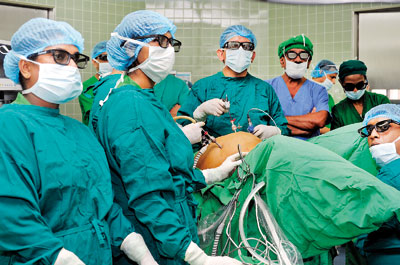
All set to perform a total laparoscopic hysterectomy at the Sri Jayewardenepura Hospital. Pix by Amila Gamage
The sessions commenced with special glasses being passed around, for the audience was to view the gynaecological procedures being performed with the use of a 3-Dimensional High Definition Laparoscopy system. While the arrangements for the workshop were handled by Consultant Obstetricians & Gynaecologists, Prof. Hemantha Perera and Dr. Madhava Karunarathna, the procedures were performed by Dr. Wan Ahamed of Malaysia’s Putrajaya Hospital and local teams in the two OTs. The teaching and follow-up queries were handled by Dr. Ahamed as well as Prof. Perera and Dr. Karunarathna.
In the audience were veterans from the field including SLCOG President Prof. Deepal Weerasekera, Dr. Rukshan Fernandopulle attached to the Colombo South (Kalubowila) Teaching Hospital and Dr. Sanath Lanerolle attached to the Castle Street Hospital for Women. Two patients underwent ‘Total Laparoscopic Hysterectomies’ and two more ‘Laparoscopic Myomectomies’ through key-hole or minimally-invasive procedures.
While a hysterectomy is the removal of the uterus (womb), this procedure can be performed in many different ways. Some methods are:
Open traditional hysterectomy, with the womb being removed through a long-cut on the abdominal wall;
Vaginal hysterectomy in which the womb is extracted through the vagina;
Laparoscopic-assisted vaginal hysterectomy when a portion of the operation (intra-abdominal) is completed with the laparoscope and the remainder of the operation (vaginal incision, excision of cervical tissues) is completed transvaginally;
Total laparoscopic hysterectomy with the whole operation being performed using the laparoscope and the surgical specimen is removed via the vagina.
A laparoscopic myomectomy is the surgical removal of fibroids (myoma) and can be performed through:
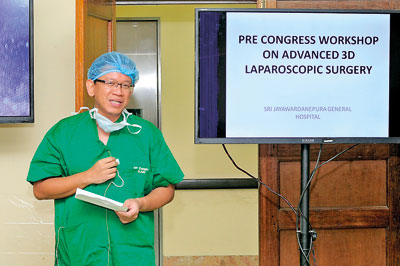
A brief talk by Dr. Wan Ahamed
Open abdominal approach Laparoscopic approach
In both a laparoscopic hysterectomy and a laparoscopic myomectomy the advantages over open surgery include minimal blood loss, quicker recovery, a shorter stay in hospital, reduced adhesions (scarring) internally and a small scar as opposed to a larger scar when taking into account the external cosmetic effect.
“The 3-D system is invaluable in intra-abdominal suturing,” reiterated Dr. Karunarathna.
Along with those in the lecture hall, MediScene gets a good view of the “inside” picture during the procedures. There is ‘depth-perception’ as well as ‘greater magnification’ through the 3-D HD System being used, allowing for more precise and meticulous dissection.
Otherwise, it is as if, we are looking at a 2-D screen but operating on a 3-D field is the consensus as the procedures take off using three ports (cuts) one for the camera and others for the instruments.
The patient is administered general anaesthesia and put to sleep, after which three tiny cuts are made, one inside the belly button and the other two laterally. A laparoscope, a medical telescope with a camera attached, is then passed into the stomach through the belly-button cut, while gas is also pumped into the tummy to expand it and separate the organs, enabling a clearer vision.
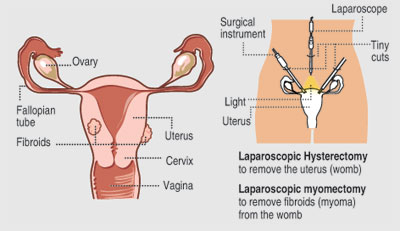 The camera, meanwhile, transmits real-time pictures onto the television screen and these are magnified in 3-D. The surgical instruments are inserted thereafter.
The camera, meanwhile, transmits real-time pictures onto the television screen and these are magnified in 3-D. The surgical instruments are inserted thereafter.
MediScene understands that unlike in a laparoscopy, in a laparotomy (open surgery), there is more tissue handling as also more exposure to air which leads to drying-up followed by adhesions (pasting due to scarring). The organs inside an ‘untouched’ abdomen are shiny, soft and have slippery surfaces which allow them to slide over each other without friction and attachment not only to each other but also to the abdominal wall. In open surgery, the organ surfaces dry up due to air-exposure, while in laparoscopy the pumped in gas opens up the tissue planes.
As there are comments such as “maara clear” and depth of perception being excellent, the ovaries are separated from the womb as they are normal and the bowel is pushed down, there are many tips from the seniors to the junior-doctors
With a strong plea to the young doctors to stop performing mini-laparotomies, they are urged to start strengthening their laparoscopic skills as that is the way forward.
The workshop was facilitated by B. Braun Lanka Pvt. Ltd.
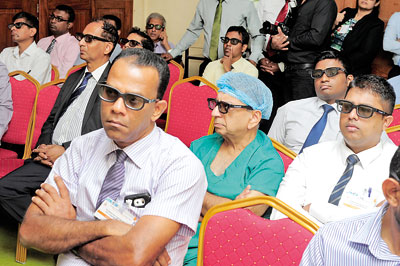
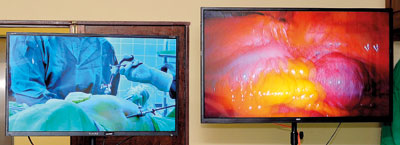
From L to r: The laparoscope and surgical instruments in place as viewed by the audience; a view of the womb on the 3-D High Definition Laparoscopy system and seeing the procedure through 3-D glasses


